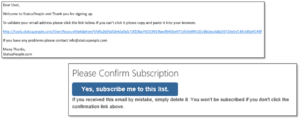What’s the difference, which should you use and when should you use it?
When it comes to email marketing, having quality data is one of the main factors that will influence the results and Return on Investment (ROI) you see from your efforts.
And good data starts with a great sign up process.
I previously wrote a post showing you 6 steps to create a top notch opt in form (there’s also a short video here >), but today I want to look at an individual part of that sign up process – the permission, also known as the opt in.
Single Opt In

A single opt involves getting permission in just one step; allowing you to immediately communicate with the subscriber via email after the completion of the form.
 This means that anyone filling in your form and clicking submit will be added to your database.
This means that anyone filling in your form and clicking submit will be added to your database.
A certain percentage of your new subscribers may provide “fake” email addresses (either an address that doesn’t exist at all or a secondary email address that they rarely check) and some may accidentally enter the wrong email; for example leaving off a letter or spelling part of it incorrectly.
One way to combat some of these issues is to use a 3rd party tool such as Briteverify which will check and verify the email address being entered to stop invalid addresses being added. However, this will not stop spam traps being accidentally added, or check if a real person exists behind the address for example.
Double Opt In

 Double opt in involves a subscriber completing your sign up form and then immediately being sent an email which asks them to click to confirm they really do want to subscribe.
Double opt in involves a subscriber completing your sign up form and then immediately being sent an email which asks them to click to confirm they really do want to subscribe.
According to a MarketingSherpa report in 2012, 39% of marketers were using double opt-in (referred to as an “opt-in only subscriber list”).
When it comes to the content of the double opt in email, it has a very distinct purpose – to get the user to click to confirm their subscription.
This email should not be confused with the welcome email – these two messages have very different purposes and should be kept separate. (You can watch a video about welcome emails here >)
The benefits of double opt in
Double opt in is the best of the best in terms of opt in processes – it checks an email address is real and validates that that person definitely wants to receive those emails, as well as getting an action immediately from the subscriber.
Double opt in therefore can be a very valuable tool to gaining slightly more engaged subscribers, help keep an accidental pristine spam traps from being added to your list or an unintended recipient, who may then be more likely to mark your email as spam; all of which can damage your sender reputation and affect deliverability.
The downsides of double opt in
However, despite these benefits, a simple fact remains – you are adding an additional step to the sign up process which can result in a slightly lower number of sign ups.
It is a well known fact that the more barriers you put in place of someone before they can complete an action, the more people will drop off along the way and not reach your end goal for them; in this case, to confirm their email address and be added to your list. If you want to increase conversions you need to remove all the obstacles you can and make each remaining step as simple, frictionless and fast as possible; Double opt in of course goes against this.
Additionally, if a subscriber doesn’t receive the double opt in email (due to the wrong email address being entered or deliverability problems for example), they will not have the chance to confirm their address – however much they may want to!
Many marketers accept a drop off of around the 20-40% mark in sign ups by using double opt in (although not much data exists from specific studies) And because of this, your list will not grow as quickly as it would if you were using a single opt in method.
Do you have to use double opt in to get good engagement rates from your list?
NO! Although some people do find their double opt in list to be highly responsive, there is no reason why a single opt in list can’t be just as responsive if managed well.
You need to use the type of opt in most suitable for the situation your business is in.
For example, if you have good data sources (organically collected sign ups from targeted, good quality traffic sources) and are at a minimal risk from low quality data you won’t necessarily need or want to use double opt in. For example, direct sign ups coming in from your own website.
But it can prove handy when using data sources where you are unsure of data quality such as affiliate/co-registration websites or when addresses are being collected in store or at a call centre where they may be input incorrectly.
In some countries, such as Germany and Canada, double opt in is often used as a way to deliver definitive proof of sign up to meet legal requirements; the level of confirmation required by the laws in these countries makes double opt in a robust way of actually meeting the requirements (although the process itself is not explicitly required by law).
Double opt in can also be useful to implement if you’ve experienced deliverability issues in the past due to data quality. Although I would suggest that if this is the case, using double opt in would just be the tip of the iceberg and much more investigation should be taking place into the source of data for example.
If you are using Double opt in – here are some ways to maximise conversion:
- Optimise the landing page after sign up – customise it and warn subscribers of the next step they need to take and what happens if they don’t – use the FOMO (Fear Of Missing Out) principal to let them know that without clicking on the link to confirm they will not be subscribed and will not receive all the wonderful things you promised them straight to their email. Prompt them to check their spam/junk (or Gmail promotional tab) in case the email is delivered there and you can even give them the option on this page to resend the double opt in email if they have not received it within a certain amount of time.
- Make the subject line of your double opt in email very clear – this is an important email that they need to act on to confirm their subscription so the first step is to get them to open it.
- Don’t mix other content in with this email – keep it clear and to the point with just one action to take – to confirm the subscription.
- Resend the double opt in email after 24/48hrs if a subscriber hasn’t confirmed – you could even consider sending a 3rd attempt after this in case the subscriber hasn’t received the message through deliverability issues for example.
- And don’t forget about the confirmation page after the subscriber has clicked – don’t just leave them hanging! Direct them to useful areas of your website or specific products/categories of product to keep up the action momentum!
Regardless of your opt in type…
As a marketer or business owner you should be concerned with the quality of the data you are driving to your opt in, as well as the quality of your strategy and how you engage subscribers going forward – after all, a sign up alone doesn’t generate revenue, you need to provide valuable, relevant and interesting content on an ongoing basis too.








